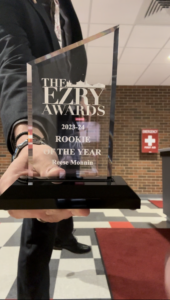On March 25, Cleveland Indians owner Paul Dolan was interviewed by Zack Meisel, a journalist for The Athletic. His comments that stood out were on superstar shortstop Francisco Lindor and his impending bank-breaking contract.
“Probably the day we [hand out a $300 million contract] is when somebody else is doing $1 billion deals,” Dolan said.
This comment came six days after Mike Trout, the superstar center fielder for the Los Angeles Angels, signed the largest contract is sports history at $426 million over 12 years.
While the comments from Dolan crushed my hopes of seeing Lindor in an Indians jersey for the rest of his career, he infuriated me with his next comment.
When asked about Lindor’s future with the team, he responded, “Enjoy him. We control him for three more years. Enjoy him and then we’ll see what happens.”
I—like many other fans—are tired of seeing small market teams battle for a year or two championship window, while big market teams remain in the hunt continuously by opening their pockets.
For years, the Yankees specifically have been taunted as winning by flaunting their wealth during free agency. While these evaluations may not always be true, major market teams typically earn a lot more money just through gate receipts and apparel sales.
Meanwhile, small market teams, such as the Indians, struggle to get fans to come to games and purchase team affiliated gear. This undoubtedly gives the major market teams a bigger revenue each year than the smaller market teams. This revenue gap affects a team’s lasting success on the field. I would like to offer up one great example of the issues between small market and major market teams.
Recently, teams like the Kansas City Royals and Chicago Cubs have won World Series by building up their farm system and signing veteran leaders. However, there is a discrepancy between Kansas City and Chicago.
The Royals, a small market team, won the World Series in 2015. This last season—just three years later—the team finished with over 100 losses. After their World Series triumph, the team has not made it back to the playoffs. With pricey free agents and aging veterans, the Royals core crumbled. The Royals have begun a rebuilding process right after their championship because they could not afford to keep their best players around anymore.
Meanwhile, the Cubs, a fan-favorite and major market team, won the World Series in 2016 and have battled in the playoffs for the last two years. The team has won over 90 games every year as well. While the Cubs have not returned to the World Series in the last few years, it is important to note that most of their core from their championship is still intact. In fact, the Cubs would probably have had a lot more success last year if not for the injuries they faced.
I think to fix this discrepancy between small market and major market teams, the MLB should fairly break up their revenue to each team by the “need.” By this I mean the less revenue the team earns due to their market, the more the MLB should pay. This would also mean small market teams would be able to retain their best players if they chose and be aggressive in free agency.






The author suggests a system not in-kind different from what is in place.The Indians received around $45 million in revenue sharing last year. Every team received $67 million when MLB sold off BAMTech. The team has made the playoffs the last three years collecting revenue from Major League Baseball has done so much to protect small market teams; all the while the league has left very little financial incentive to win. Not coincidently the players share of revenue has shrunk, to historically low levels. The economics of the game are beyond pointing towards a work stoppage and I am afraid this type of pro-owner argument only makes that more likely.